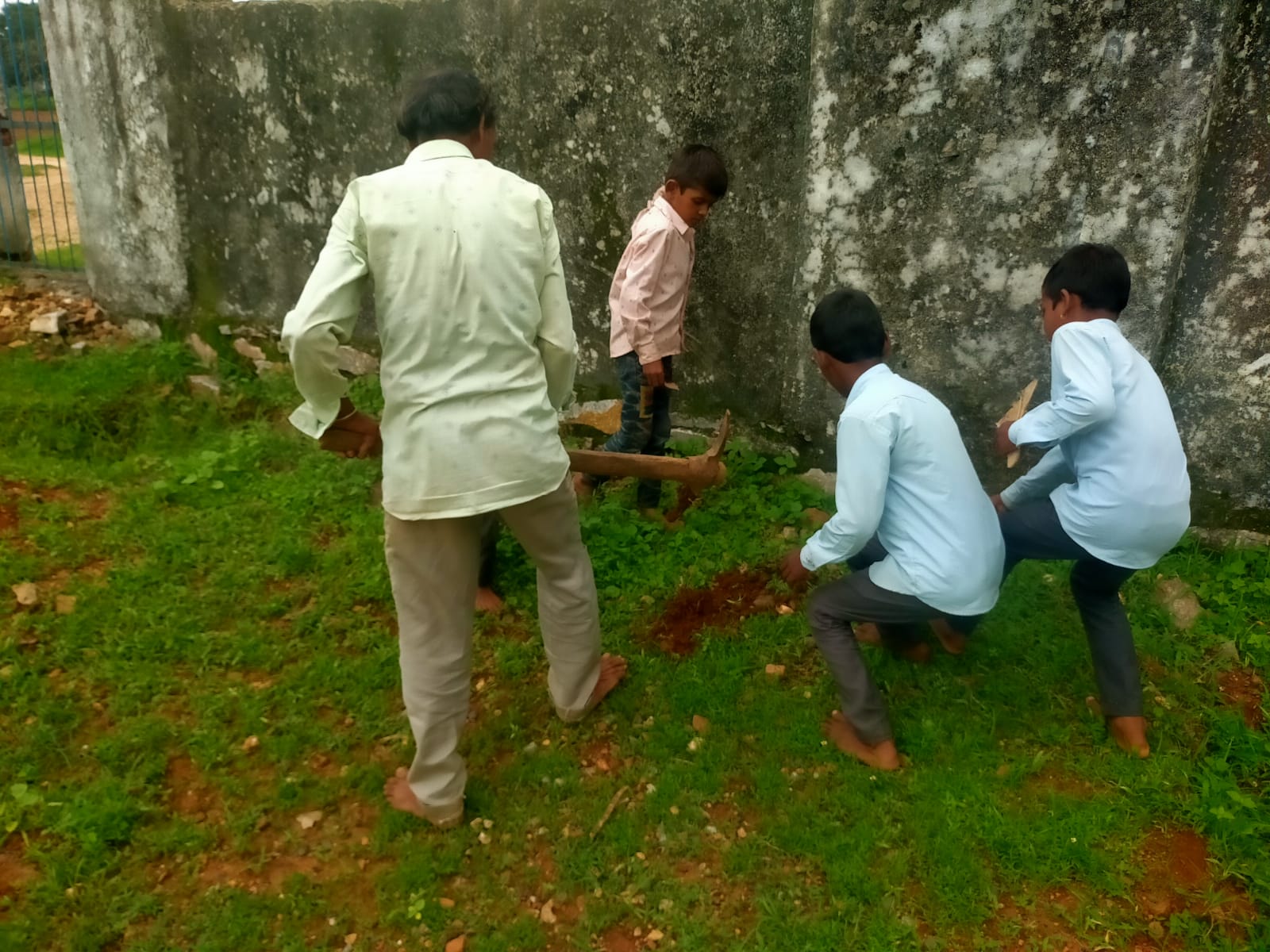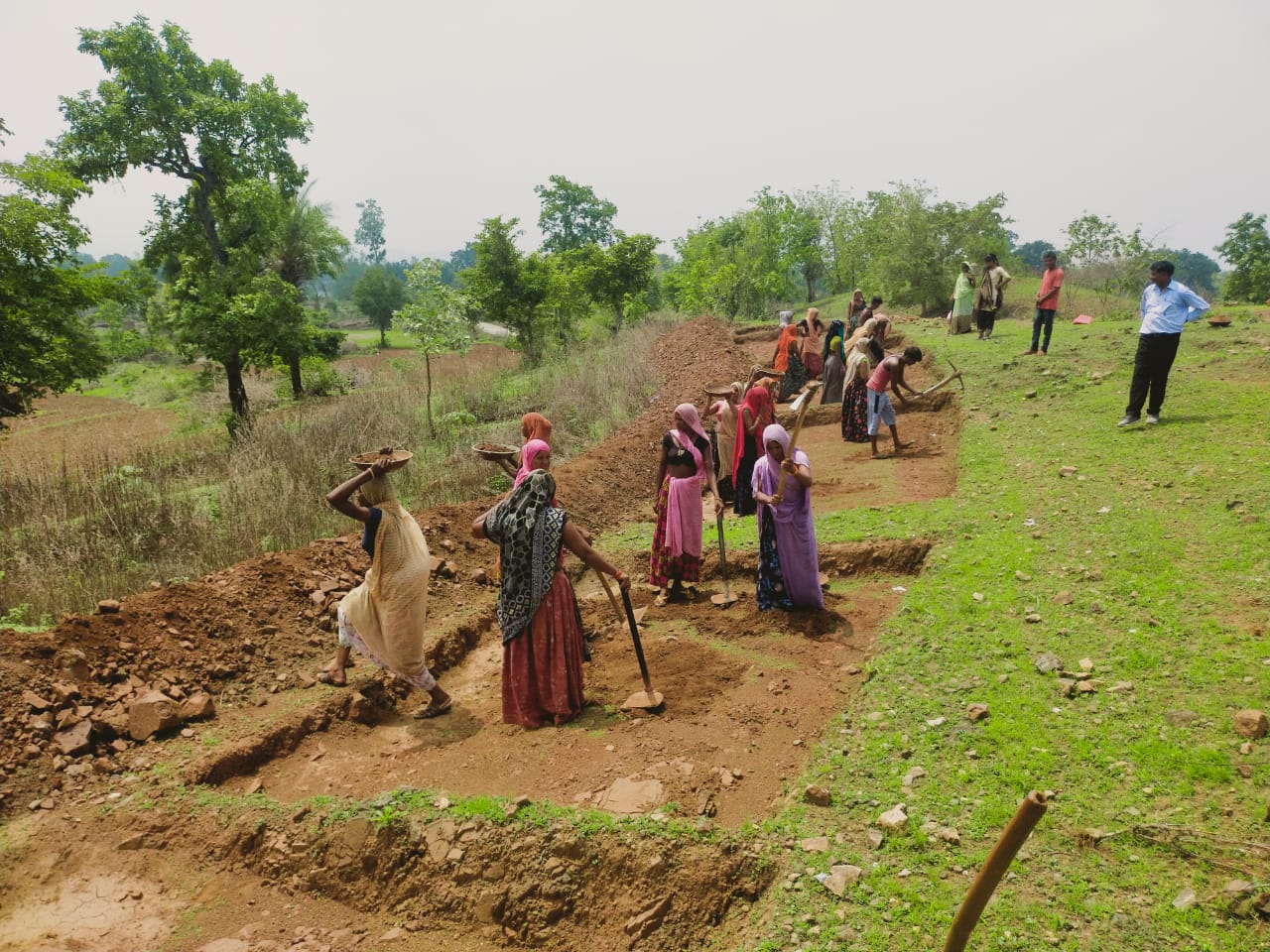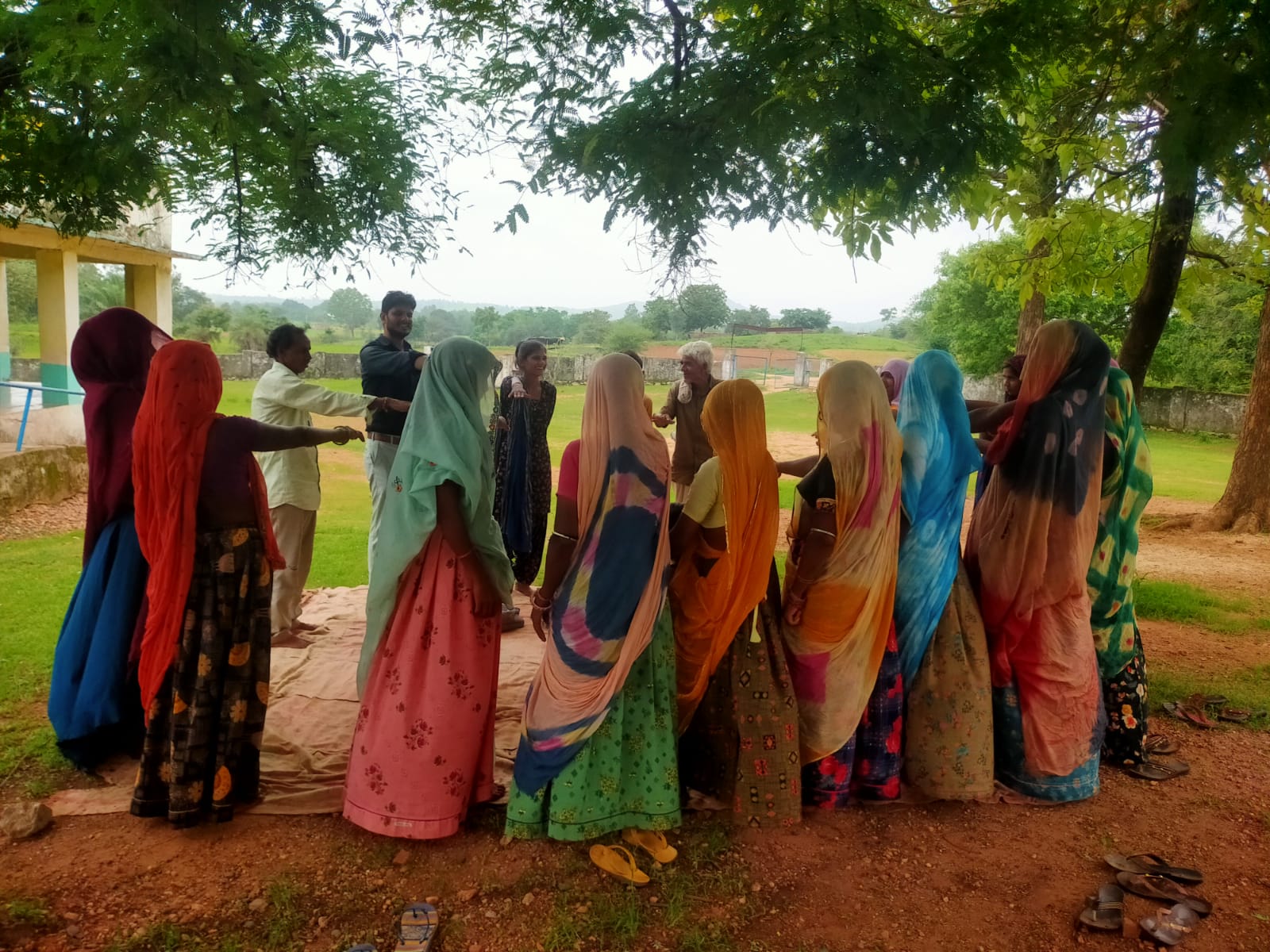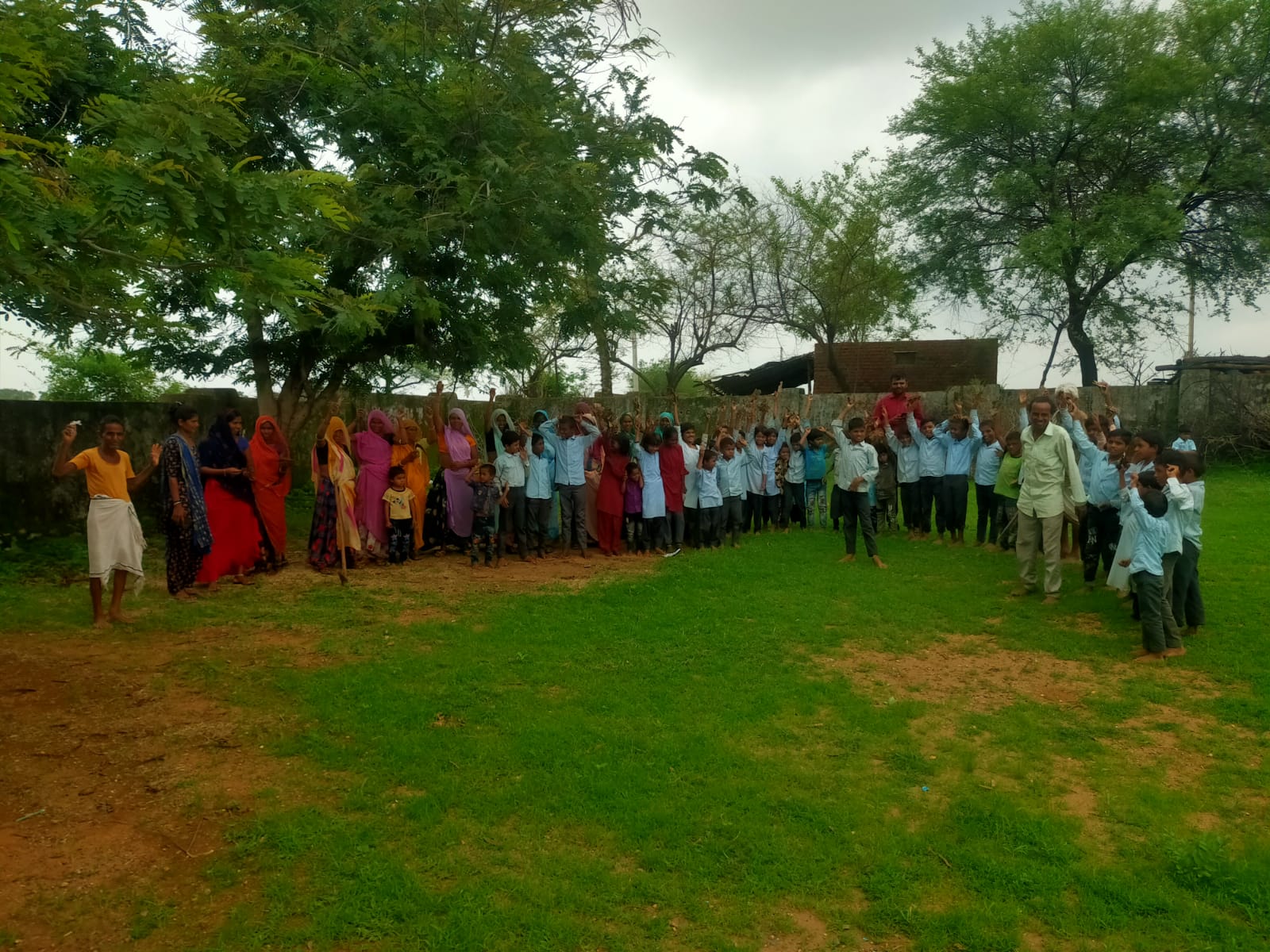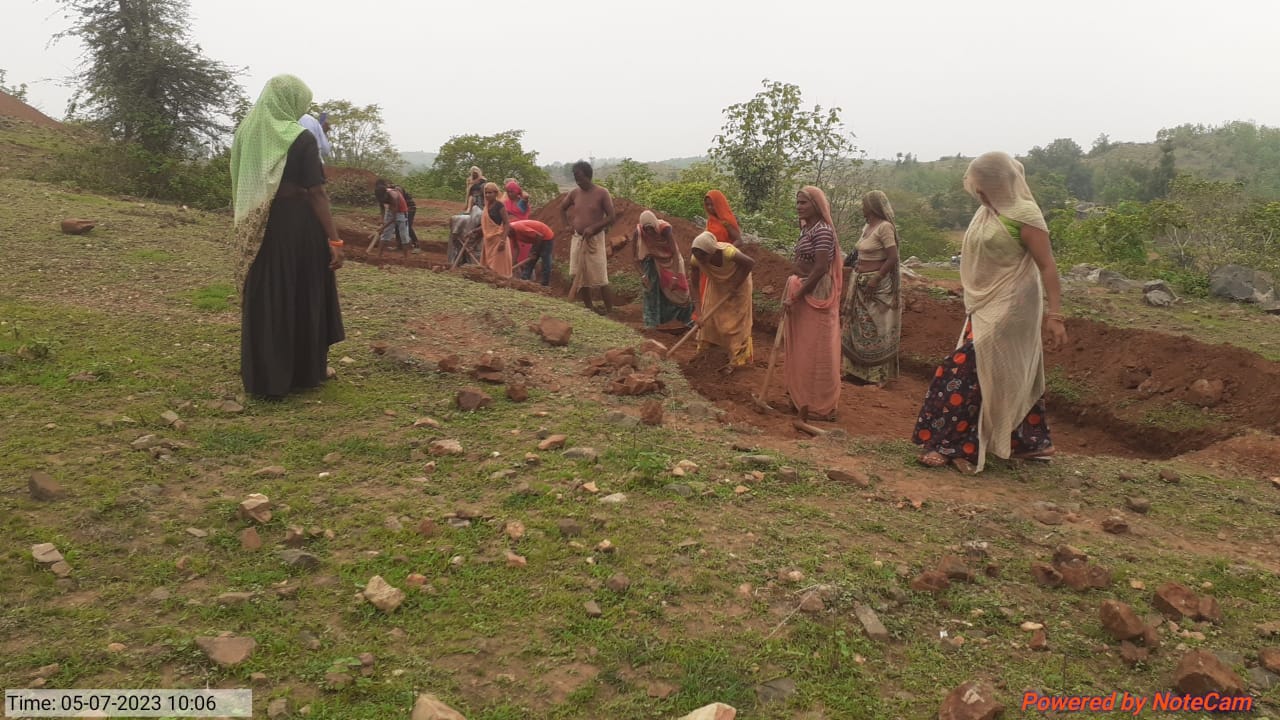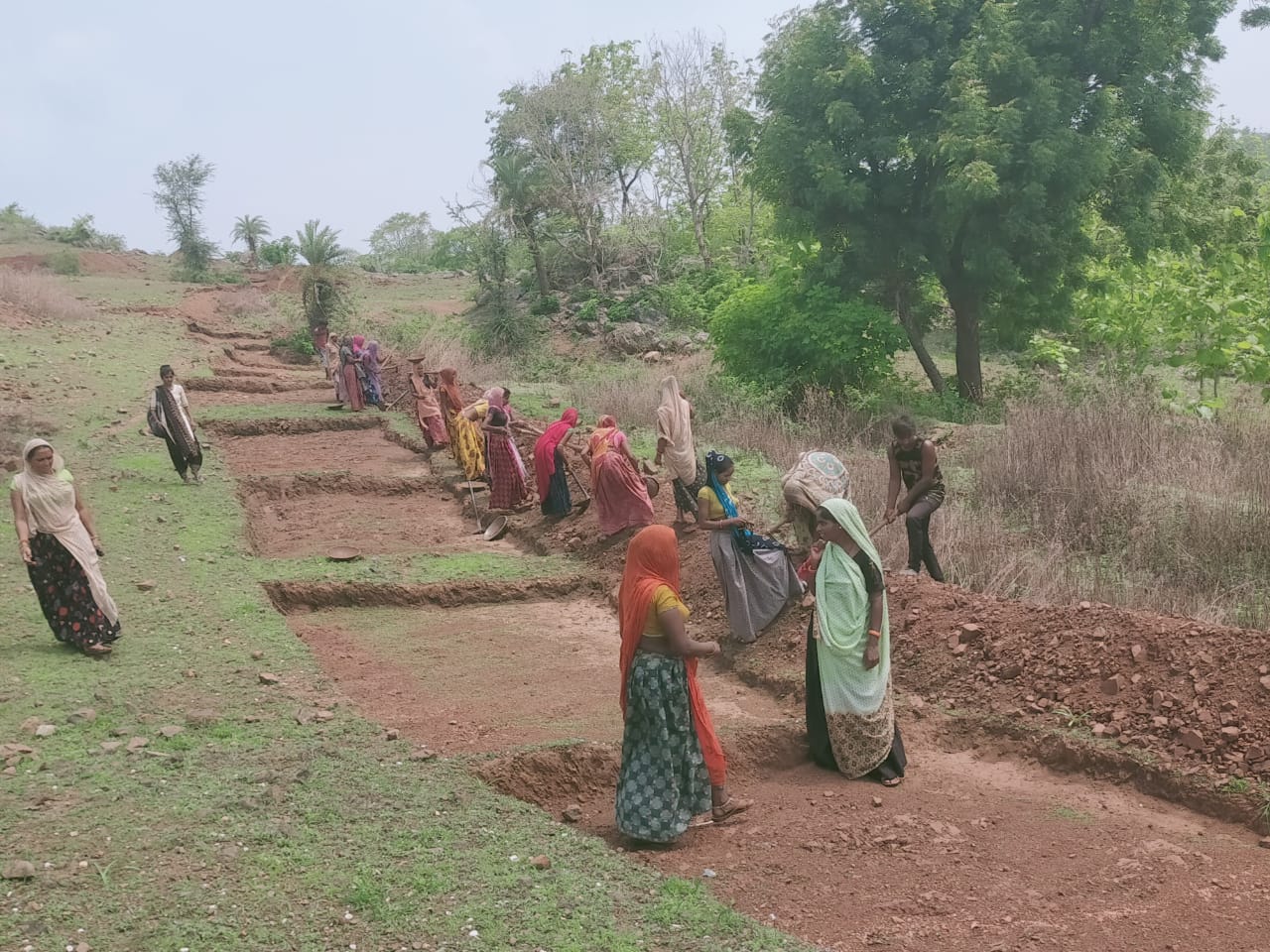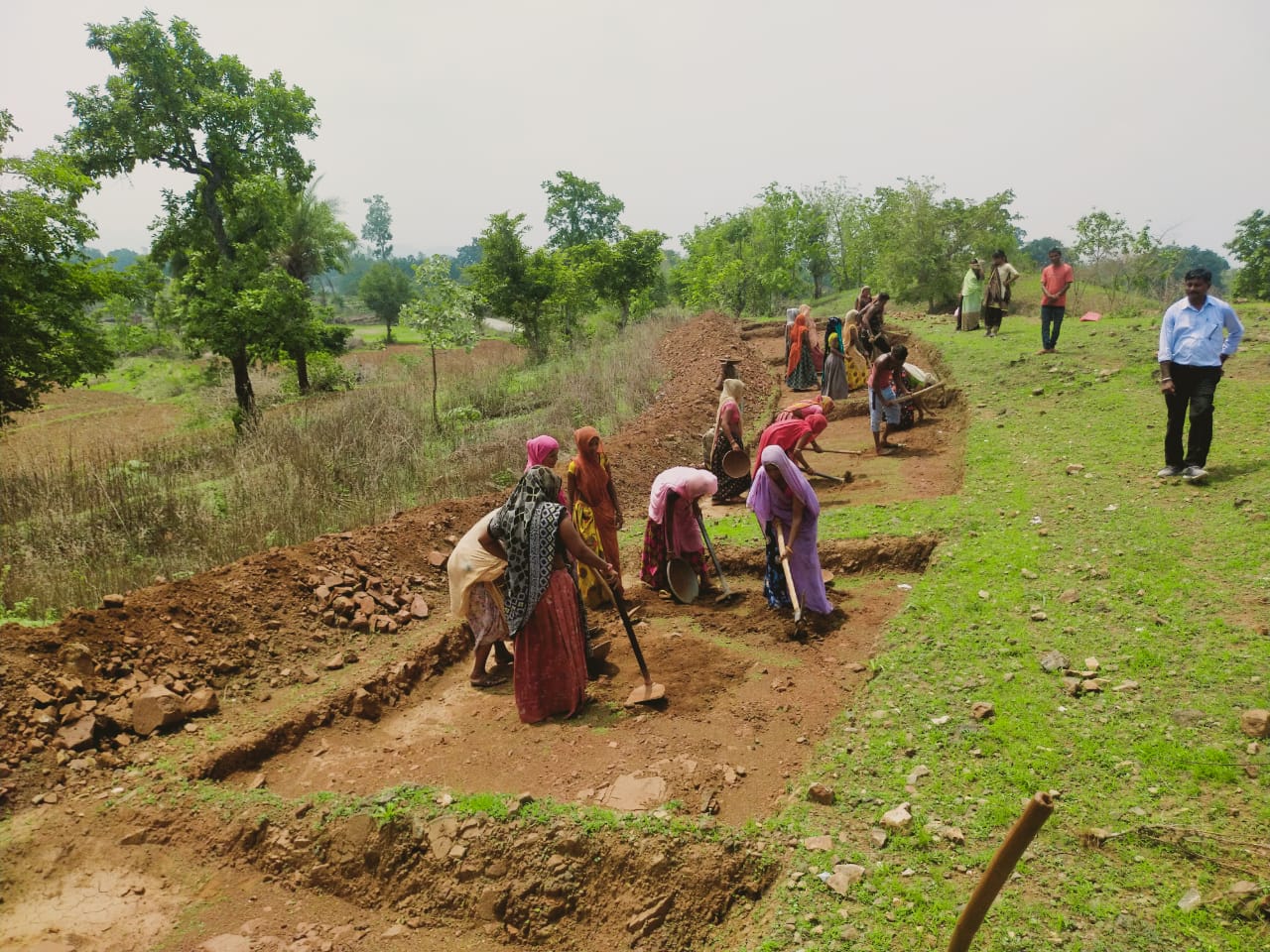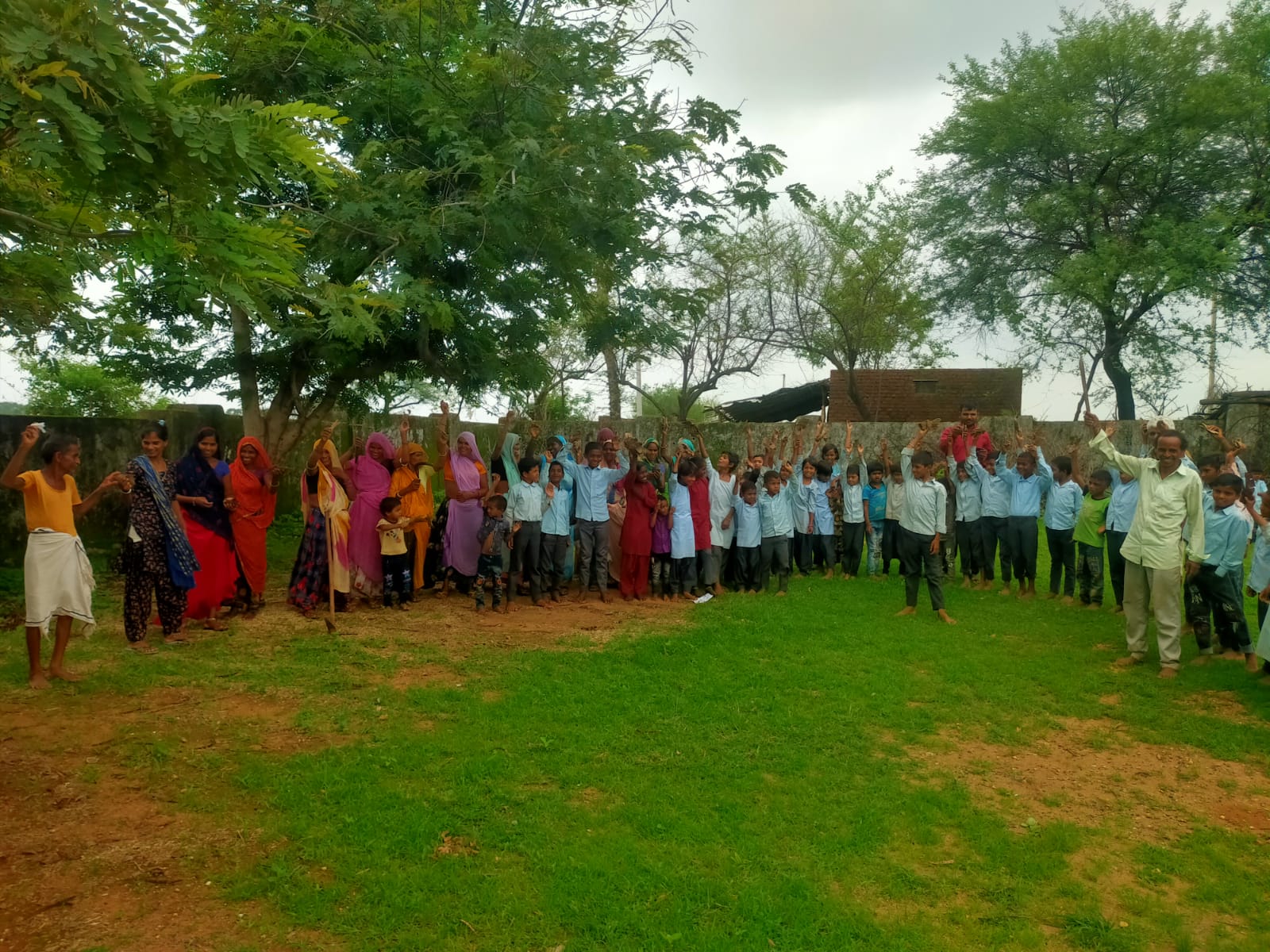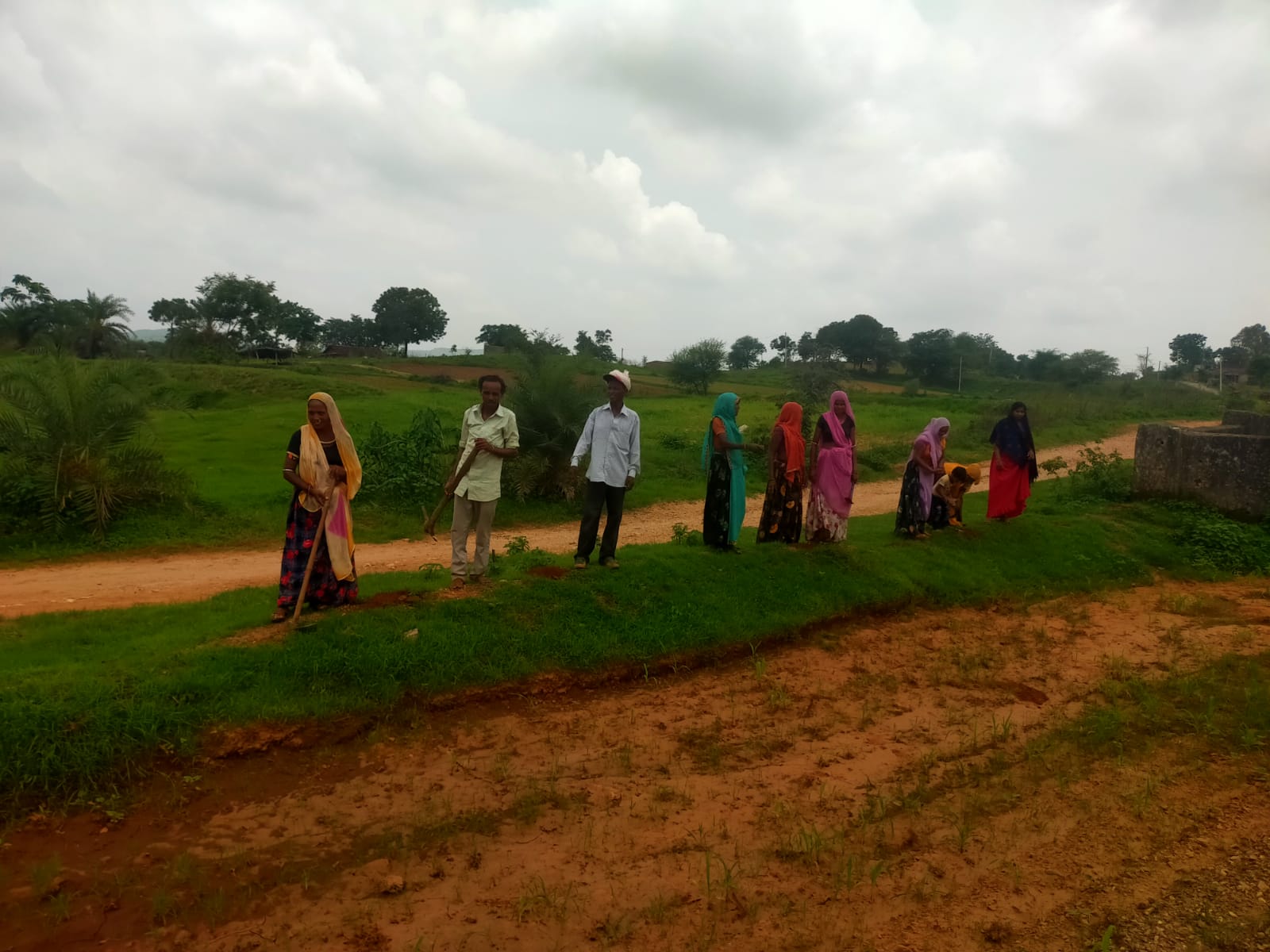Miyasa village is situated in the hilly region of Ghatol block in Banswara district, lying on the Aravalli Plateau. The area is known for frequent droughts and labor migration, but many problems contribute to the crisis that the local Bhil tribal community is facing. Being faced with adversity, some tribals have started turning to the traditional practice of Halma (community collective action), with the help of which they are planting castor, khakhra, and Timaru on community land and sowing and harvesting crops all throughout the village.
For the tribal communities of Banswara district, low agricultural yields and water shortages are the main issues. The two are linked as, beyond the most acute concern for drinking water, a water shortage also leaves less water available to irrigate crops outside of the rainy season. Thus, many farmers are limited to one crop per year- during the monsoon. Because this does not cover their needs for food, let alone income, many are pushed into a vicious cycle of labor migration, exploitation, and hunger.
But these days in Miyasa village, the tribal population has saved lakhs of rupees by sowing and fencing their fields with the help of the community. This village of Bhil tribals may have found a solution to the problems they were facing in farming and other aspects of life.
Mrs. Amri Devi Ninama, a member of the Gram Swaraj Sangathan formed by Vaagdhara, tells us about Halma: “Halma is an ancient tradition of our Bhil community. When a person is trapped in a crisis in the village and even after applying all his strength, he cannot get out of that crisis, then he invokes Halma. The people of the village get that person out of trouble by fulfilling their social responsibility of participating in Halma.”
Mrs. Jamana Ninama, a member, recounts: “We had called Halma to deal with the crisis of non-availability of field workers in the village. With this Halma, under community participation, about 15 farmers sowed their fields with each other’s help and without spending a single penny. Around 25 people helped on each farmer's field. Accordingly, we can say that over 300 people did HALMA in each other's fields, saving a lot of time and money for the farmers.
For the last 20 years, Vaagdhara has been giving training to the tribal people in this area, including on constructing dams and ponds, the adoption of organic farming systems under true farming, benefiting from government schemes, their rights and participation in Panchayat-level politics, community development, and much more.
Devi Lal Ninama, a member of the Krishi Evam Adivasi Swaraj Sangathan, tells us, “The Bhil tribe lives in these villages. It is a hilly, semi-arid area prone to intense rainfall during the monsoon. The average annual rainfall here is usually around 900 milliliters, while the temperatures range from a maximum of 45 degrees Celsius to a minimum of 7 degrees throughout the year. Red, black, stony, loamy soil is mostly found here. The tribes living here depend on the biodiversity here. That's why these tribes keep their ancient traditions and natural knowledge within themselves. Due to this, the forests are also preserved, and the tribal communities are maintaining their existence.
Keshav Ninama, a youth of Miyasa village, frequently migrates to Gujarat for wages. Keshav and his father have three bighas of land without access to irrigation, from which they grow only rain-fed maize and tuvar. Maize is useful only for eating at home. They are not able to sell it in the market and there is no profit from the crop. Cash is always tight at home. That's why half of the family had to start migrating to other states for wages because laborers were not available to do farming and our on-farm expenditure was also very high. But now, he stopped migrating outside thanks to the help he got with sowing and harvesting the crops after invoking Halma. We have now solved our own needs in the village by helping each other and we will make community participation through Halma our way of development.”
हलमा: सामुदायिक भागीदारी से अपनी समस्याओं का हल निकालते जनजातिय समुदाय !
अरावली पठार में आने वाला बांसवाडा जिले के तहसील घाटोल का पहाड़ी क्षेत्र वाला गाव मियासा । यह इलाका पलायन और सूखे के लिए जाना जाता है। यहां रहने वाले भील समुदाय के आदिवासियों के लिए कई समस्याएं संकट लेकर आती है। इस समस्या का समाधान आदिवासियों ने अपने पारंपरिक ज्ञान में खोजा। सामुदायिक भागीदारी ‘हलमा’ की मदद से यहां कई जगह मेडबंदी ,फसल बुवाई ,फसल कटाई ,और सामुदायिक भूमि पर अरंडी ,खाकरा टिमरू के बीज लगाकर पर्यावरण संवर्धन कर रहे है I
दरअसल, कम खेती उपज ,पानी संकट बांसवाड़ा जिले में रहने वाले आदिवासियों की प्रमुख चिंता है। ये संकट उनके लिए कई समस्याएं लेकर आता है। पीने के पानी समस्या तो इनमें सबसे विकराल है। फसलों को पानी देने का संकट अलग से है। इससे वे साल में सिर्फ एक ही फसल ले पाते हैं। इसके चलते पलायन, मजदूरी, भुखमरी और शोषण का कुचक्र शुरू होता है ।
लेकिन इन दिनों मियासा गांव में इन आदिवासीयो ने सामुदायिक तरीके से एक दुसरे के खेतों में बुवाई ,मेडबंदी करके लाखों रुपये की बचत कर चर्चा में है । इसे अनेक समस्या ग्रसित भील आदिवासियों के इस गांव ने कृषि और अन्य की समस्या का समाधान खोज लिया है ।
वागधारा गठित ग्राम स्वराज संगठन की सदस्य श्रीमती अमरी देवी निनामा हलमा के बारे में बताती हैं, हमारी भील समाज की हलमा एक प्राचीन परंपरा है। जब कोई व्यक्ति गांव में संकट में फस जाता है और अपनी पूरी ताकत लगाने के बाद भी उस संकट से नहीं निकल पाता, तो वो हलमा का आह्वान करता है। गांव के लोग हलमा के जरिए सामाजिक दायित्व निभाकर कर उस व्यक्ति को संकट से निकालते हैं ।”
वही एक ओर सदस्य श्रीमती जमाना निनामा बताते हैं, “हमने गांव में खेतों में काम करने के लिए मजदूर नहीं मिलते इस संकट से निपटने के लिए हलमा बुलाया था। इसी हलमा से सामुदायिक भागीदारी के तहत बिना एक पैसा खर्च किए तकरीबन 15 किसानों ने अपने खेतों में सामुदायिक तरीके से बुवाई की इसमें एक किसान के खेत में 25 लोग सहभागी हुए इस हिसाब से 300 किसानों ने एक दूसरे के खेतों में श्रमदान किया हलमा द्वारा पेशा और समय भी बचाया है ” I
वागधारा संस्था इस क्षेत्र पिछले 20 वर्ष से इन जनजातिय लोगों को ,मेडबंदी ,तालाब निर्माण,सच्ची खेती के तहत जैविक खेती प्रणाली अपनाने, सरकारी योजनाएं लाभान्वित करने हेतु, और पंचायत में अपने अधिकार एवं भागीदारी ,सामुदायिक विकास आदि के बारे में प्रशिक्षण देते आ रहे हैं ।
कृषि एवं आदिवासी स्वराज संगठन के पदाधिकारी देवी लाल निनामा हमें बताते हैं, “हमारे गांवों में भील जनजाति रहती है। यह पहाड़ी, अर्ध-शुष्क जलवायु वाली मानसून की अनिश्चितता से जूझता इलाका है। यहां आमतौर पर औसत वार्षिक वर्षा 900 मिली लीटर के आसपास होती है। वहीं अधिकतम तापमान 45 डिग्री सेल्सियस तो न्यूनतम सात डिग्री सेल्सियस के आसपास होता है । यहां लाल, काली, पथरीली, दोमट मिट्टी पाई जाती है । यहां रहने वाली जनजाति यहां की जैव-विविधता पर निर्भर है । इसलिए ये जनजाति अपनी पुरातन परंपराओं और कुदरती ज्ञान को अपने अंदर समेटे हुए है । इसके चलते जंगल भी बचे हुए हैं और जनजाति समुदाय भी अपना अस्तित्व बनाए हुए है ।”
मियासा गाँव के युवा केशव निनामा मजदूरी के लिए गुजरात जाते हैं । केशव और उनके पिता के पास बिना सिंचाई वाली तीन बीघा जमीन है जिससे वे केवल बारिश में बोई जाने वाली मक्का और तुवर उगा पाते हैं । मक्का सिर्फ घर में खाने में काम आता है । उसे वे मंडी में नहीं बेच पाते और फसल से मुनाफा नहीं हो पाता । घर में नगदी की हमेशा तंगी रहती है । इसलिए आधे परिवार को मजदूरी के लिए दूसरे प्रदेशों में जाना पड़ता था, क्यों की खेती करने के लिए मजदूर नहीं मिलते थे और खर्चा भी बहुत होता था पर अब खेती में फसल बुवाई और कटाई हलमा द्वारा करने से मैं बाहर पलायन नही जा रहा हु । हमें अभी गांव में और एक दूसरे की मदद करके अपनी की जरूरत का हल निकाल लिया है और हम हलमा के जरिये सामुदायिक भागीदारी अपनी विकास की राह से बनाएंगे।”


